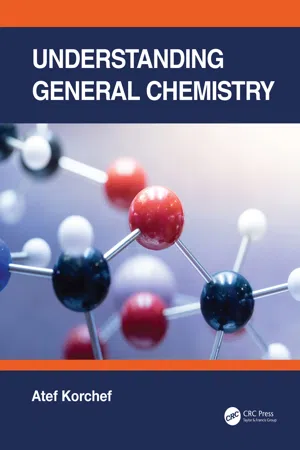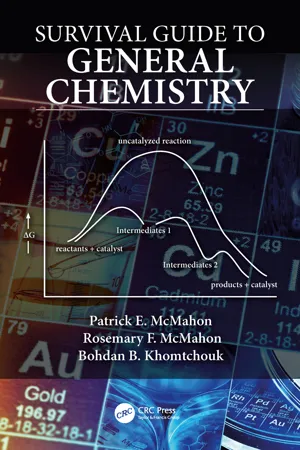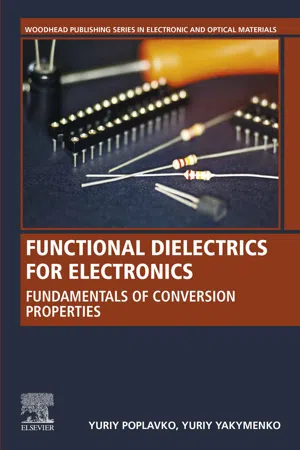Chemistry
Polar and Non-Polar Covalent Bonds
Polar covalent bonds occur when atoms with different electronegativities share electrons unequally, resulting in a partial positive and partial negative charge on the atoms. Non-polar covalent bonds form when atoms with similar electronegativities share electrons equally, leading to no net charge on the atoms. These types of bonds are important in understanding the behavior of molecules and their interactions.
Written by Perlego with AI-assistance
Related key terms
Related key terms
1 of 4
Related key terms
1 of 3
9 Key excerpts on "Polar and Non-Polar Covalent Bonds"
- eBook - ePub
- Atef Korchef(Author)
- 2022(Publication Date)
- CRC Press(Publisher)
The electrons involved in bonding are usually those in the outermost (valence) shell. There are three types of chemical bonds:- A covalent bond results from sharing electrons between the atoms. The covalent bond is usually found between non-metals. The covalent bond can be polar or non-polar.
- Examples of molecules showing polar covalent bonds: HCl, HBr and H2 O
- Examples of molecules showing non-polar covalent bonds: Homonuclear diatomic molecules such as I2 , Br2 , Cl2 , O2 and F2 , and hydrocarbons (Cn H2n + 2 ). A non-polar covalent bond in I2 and a polar covalent bond in HCl.
- An ionic bond results from the transfer of electrons from a metal to a non-metal.
- Example: The bond between sodium (Na) and chlorine (Cl) in NaCl is an ionic bond. The NaCl compound obtained is an ionic compound.
- A metallic bond is formed between positively charged atoms in which the free electrons are shared among a structure of positively charged ions. Metallic bonding is the main type of chemical bond that forms between metal atoms.
Lewis dot representation or electron dot diagram is a simplistic way of showing the valence electrons of an atom that uses dots around the chemical symbol of the element with no more than two dots on a side. To represent the Lewis dot diagram of an atom, carry out the following steps:- Write out the electronic configuration of the atom or the ion.
- Find the number of valence electrons.
- Draw the valence electrons as dots around the chemical symbol of the atom or the ion.
- Example: The seven valence electrons of Cl are drawn in the following configuration:
- Example: 7 N and 15 P belong to the same group (Group 15) and have similar Lewis dot diagrams:
Electron dot diagrams for ions are like those of atoms, except that some electrons have been removed from or added to a neutral atom to obtain an ion. Conventionally, when we draw electron dot diagrams for ions, we show the original valence shell of the atom and not the valence shell of the ion. - Mark Kernion, Joseph A. Mascetta(Authors)
- 2022(Publication Date)
- Barrons Educational Services(Publisher)
This typically occurs when two nonmetal atoms are around each other. This will not occur when two metal atoms are around each other as neither has a strong desire for more electrons. On the other hand, nonmetals do have a relatively strong desire for more electrons. The only way for that to be satisfied is if the interacting atoms share their valence electrons. The difference between the level of potential energy before the bond and that once the bond has been formed is called the bond energy. The distance between the nuclei of the atoms in their optimum position is referred to as the bond length. When nonmetal atoms interact in this manner, it is called a covalent bond. FIGURE 3.1 Interaction of Nonmetal Atoms to Share Electrons and Form a Covalent Bond When the electronegativity difference between two or more atoms is 0 or very small (not greater than about 0.4), the atoms tend to share the valence electrons in their respective outer energy levels equally. This interaction is called a nonpolar covalent bond as the electrons are not really pulled toward one side of the bond or another. TIP Nonpolar covalent bonds involve a sharing of electrons between atoms. Their electronegativity difference is between 0 and 0.4. When the electronegativity difference is between 0.4 and 1.6, there will not be an equal sharing of electrons between the atoms involved. The shared electrons will be more strongly attracted to the atom with greater electronegativity. As the difference in the electronegativities of the two elements increases above 0.4, the polarity or degree of ionic character increases. At a difference of 1.7 or greater, the bond is 50% or more ionic character. However, when the difference is between 0.4 and 1.6, the bond is called a polar covalent bond. TIP Polar covalent bonds have unequal sharing of electrons- eBook - ePub
- Jeffrey Gaffney, Nancy Marley(Authors)
- 2017(Publication Date)
- Elsevier(Publisher)
Trigonal bipyramidal T-shaped 90 5 3 2 Trigonal bipyramidal Linear 180 6 0 6 Octahedral Octahedral 90 6 1 5 Octahedral Square pyramidal 90 6 2 4 Octahedral Square planar 903.7 Molecular Polarity
As explained in Section 3.3 , polar covalent bonds occur when two bonded atoms have different electronegativities and share the electrons unequally, while nonpolar covalent bonds occur when two bonded atoms have the same electronegativities and share the electrons equally. Molecules can also be polar or nonpolar depending on the overall polarity of the bonds in the molecule. The polarity of the molecule is the sum of all of the individual bond polarities in the molecule. Since the dipole moment of each bond is a vector quantity with both magnitude and direction, the dipole moment of the molecule is determined as the vector sum of the individual bond dipole moments. Also, because the molecular polarity is a vector sum, the polarity of all bonds, however small, must be considered unless they are truly nonpolar with a dipole moment of 0.0D .A molecule that contains no polar covalent bonds (all bonds = 0.0D ) will have no charge difference between one part of the molecule and another part and the molecule will be nonpolar. A polar molecule occurs when electron density accumulates in one part of the molecule giving it a partial negative charge (δ− ). The other side of the molecule will then have an equally partial positive charge (δ+ ). Since diatomic molecules have only one bond, if that bond is polar, the molecule will be polar, as in HBr. Or, if the bond is nonpolar the molecule will be nonpolar, as in HAt. In polyatomic molecules, the molecular polarity is determined from the sum of all of the individual bond polarities and how they are oriented in space (molecular geometry). For example, consider CO2 - Christopher R. Hren, John T. Moore, Peter J. Mikulecky(Authors)
- 2022(Publication Date)
- For Dummies(Publisher)
dipole (think of a magnet). The polar bonds within a molecule add to create polarity in the molecule as a whole. The precise way in which the individual bonds contribute to the overall polarity of the molecule depends on the shape of the molecule:- Two very polar bonds pointing in opposite directions: Their polarities cancel out.
- Two polar bonds pointing in the same direction: Their polarities add.
- Two polar bonds pointing at each other so they’re diagonal to one another: Their polarities cancel in one direction but add in a perpendicular direction.
Figure 10-12 shows a couple of examples of molecules in which dipoles have formed.FIGURE 10-12: Polar covalent bonding in HF and NH3 .In hydrogen fluoride (HF), the bonding electron pair is pulled much closer to the fluorine atom than to the hydrogen atom, so the fluorine end becomes partially negatively charged and the hydrogen end becomes partially positively charged. The same thing takes place in ammonia (NH3 ); the nitrogen has a greater electronegativity than hydrogen, so the bonding pairs of electrons are more attracted to it than to the hydrogen atoms. The nitrogen atom takes on a partial negative charge, and the hydrogen atoms take on a partial positive charge.The presence of a polar covalent bond explains why some substances act the way they do in a chemical reaction: Because this type of molecule has a positive end and a negative end, it can attract the part of another molecule with the opposite charge.In addition, this type of molecule can act as a weak electrolyte because a polar covalent bond allows the substance to act as a conductor. So if a chemist wants a material to act as a good insulator- No longer available |Learn more
- Steven Boone, Drew H. Wolfe(Authors)
- 2011(Publication Date)
- Collins Reference(Publisher)
CHAPTER 10Chemical Bonding: Fundamental Concepts
A chemical bond is the force of attraction that one atom (or ion) has for another atom (or ion). The principal driving force for atoms to combine and form molecules is the release of energy by atoms as they stabilize through bonding. The two principal types of bonds discussed in this chapter are ionic and covalent bonds.10.1 INTRODUCTION TO CHEMICAL BONDINGChemical bonds are the forces that hold atoms together when compounds are formed. Ionic or Electrovalent BondsIonic bonds most commonly result when one or more electrons transfer from a metal to a nonmetal. When this occurs, the metal atom becomes a cation, and the nonmetal atom becomes an anion. Ionic bonds are the electrostatic forces of attraction among the resulting positive and negative ions.Covalent BondsA covalent bond results when the orbitals of two nonmetal atoms overlap and the nuclei of the atoms attract the electrons in the overlapping region. This is called electron sharing .Bonding TheoriesThe valence bond and molecular orbital theories are most often used to explain the properties and formation of chemical bonds. The Valence Bond Theory primarily considers the interactions of the electrons in the outer shell (valence electrons) in the formation of bonds. The Molecular Orbital Theory considers the energies of all the electrons in the atoms that form chemical bonds. Scientists use both theories to explain chemical bonds and molecular structures, because neither can explain adequately the bonds in all chemical species.Lewis Symbols and Lewis FormulasThe valence electron configurations of the atoms are often shown using Lewis symbols and Lewis structures. To write the Lewis symbol of an atom, place as many dots around its symbol as there are valence electrons. For example, one way to write the Lewis symbol of N is shown in Figure 10.1. Five dots are placed around the symbol of nitrogen because it has five valence electrons, 2s2 2p3 - eBook - ePub
- Patrick E. McMahon, Rosemary McMahon, Bohdan Khomtchouk(Authors)
- 2019(Publication Date)
- CRC Press(Publisher)
EN) between the two bonded atoms. An approximate, arbitrary classification is:(∆EN) < 0.5 = weakly polar bond (∆EN) = 0.5 to 1.0 = moderately polar bond (∆EN) > 1.0 = strongly polar bondA convention used for analysis of complete molecules designates a polar covalent bond with a dipole arrow = (+ →); the “cross” end of the arrow is placed over the relatively positive (δ+) atom of the covalent bond, and the arrow point is placed over the relatively negative (δ–) atom of the covalent bond:Example: Determine the (∆EN) for the following bonds and classify the bonds as weakly polar, moderately polar, or strongly polar: C—H; C—O; O—H; H—F.Molecular polarity measures the total vector sum of all bond polarities in a complete molecule; this is termed the molecular dipole moment. The dipole moment is proportional to the strength of each individual bond dipole and to the direction of each bond dipole distributed around a central atom. Bond dipoles pointing in the same direction add to produce a larger vector sum for the molecular dipole. Bond dipoles pointing in opposite directions partially or completely subtract (cancel out) to produce a smaller vector sum for the molecular dipole.The requirement for a molecule to be polar is that it must be electronically “lopsided,” referring to the distribution of electron density. Relating to mass density, a ball will wobble in flight only if the mass around the center is distributed asymmetrically; i.e., if the ball is lopsided. A ball, such as a baseball or golf ball, has several different material densities representing the core, the winding, and the cover. The balls are not lopsided because each of the materials is distributed symmetrically around the center. A central atom may show varying electron densities through polar bonds, but, if the polar bonds are distributed symmetrically around the central atom, the electron density will not be lopsided and the central atom will not contribute to polarity. - eBook - ePub
- Jacob N. Israelachvili(Author)
- 2010(Publication Date)
- Academic Press(Publisher)
5 Interactions Involving the Polarization of Molecules5.1 The Polarizability of Atoms and Molecules
We now enter the last category of electrostatic interactions that we shall be considering: those that involve molecular polarization. This involves the dipole moments induced in molecules by the electric fields emanating from nearby molecules. Actually, we have already been much involved with polarization effects: whenever the macroscopic dielectric constant of a medium entered into our consideration, this was no more than a reflection of the way the molecules of the medium are polarized by the local electric field. Here we shall look at these effects in more detail, starting at the molecular level. We shall find that apart from the purely Coulombic interaction between two charges or permanent dipoles in a vacuum, all the other interactions are essentially polarization-type interactions.All atoms and molecules are polarizable. Their (dipole) polarizabilityα is defined according to the strength of the induced dipole moment u ind they acquire in a field E —that is,(5.1) For a nonpolar molecule, the polarizability arises from the displacement of its negatively charged electron cloud relative to the positively charged nucleus under the influence of an external electric field. For polar molecules, there are other contributions to the polarizability, discussed in the next section. For the moment, we shall concentrate on the polarizabilities of nonpolar molecules, which we shall denote by α 0 .As a simple illustrative example of how polarizability arises, let us imagine a one-electron “Bohr” atom whose electron of charge –e circles the nucleus of charge +e at a distance R ; this would also define the radius of the atom (Figure 5.1 a). If under the influence of an external field E the electron orbit is shifted by a distance l from the nucleus (Figure 5.1 - eBook - ePub
Functional Dielectrics for Electronics
Fundamentals of Conversion Properties
- Yuriy Poplavko, Yuriy Yakymenko(Authors)
- 2020(Publication Date)
- Woodhead Publishing(Publisher)
Fig. 1.10 : given in both normal state and under electrical field influence.Fig. 1.10 Simplified model of polarization in different atomic and ionic chains: (A) Symmetric distribution of electron density in covalent lattice (arrows symbolize opposite orientation of electron pair spins); (B) polarization of covalent lattice with electrostriction Δl /l in applied electrical field; (C) symmetric ionic lattice where repulsion is due to overlap of electron shells; (D) polarization of ionic lattice and electrostriction Δl /l in applied electrical field; (E) hybridized bond that leads to polar properties of crystals; (F) switching of hybridized bonds in electrical field.In the covalent crystal , electrons are equally distributed around their atoms; moreover, electron density between atoms is rather large. The most important property of covalent structure is the openness of the structure, due to the small number of neighboring atoms (four in total) and mutual coupling of electronic pairs having opposite spin. From this follows, by the way, higher electronic polarizability of covalent crystals (ɛ opt = 7–15) and the highest possible mobility of free electrons in them. For further understanding of the model under discussion, it is important here that the externally applied field deforms electron shells of atoms by stretching them, which leads both to electrostriction x = Δl /l ~ E 2 and to increased polarization due to relatively free displacement of clots of electron density (Fig. 1.10B ).In ionic crystals the mutual attraction of cations and anions is compensated by repulsion of partially overlapping electron shells as well as by essential deformation of electron shells of ions. In contrast to covalent (atomic) crystals, in which magnetic attraction of spins dominates in outer shells, in ionic crystals the outer electron shells are under the action of an electrical field of dissimilar ions (Fig. 1.10C ). In an external electrical field, cations and anions are forced to be displaced, which gives such a deformation of electron shells of ions so that virtual formations of electron pairs become possible. That is why external field application is accompanied by electrostriction (Fig. 1.10D ), the value of which is proportional not only to E 2 but also to ɛ 2 . If in covalent dielectrics and semiconductors, as a rule ɛ ~ 10, then in some highly polarizable nonpolar ionic crystals (paraelectrics) it reaches 102 –104 - eBook - ePub
- William Brock(Author)
- 2012(Publication Date)
- HarperPress(Publisher)
Whereas non-polar bonds were clearly fixed in space, as classical structural chemistry demanded, because electrostatic forces were radially symmetric, the polar bond was not. Thomson’s image of a vector bond, and Fry’s, and Bray and Branch’s, attempts to notate the exchange of electrons by adding a directional arrow to the bond line (e.g. Na→Cl), was misleading. How could one tell from which atom electrons came in two contrasting compounds like HCl and CCl 4 ? As Lewis commented 7 : Since all electrons are alike, and presumably leave no trail behind them, we cannot say that atom A loses an electron to atom B and atom C to atom D, but only that atoms A and C have each lost an electron and atoms B and D have each gained one. This was to become a key point in the new quantum mechanics. Developments now came thick and fast. In England, Thomson was forced to abandon the plum-pudding model by Rutherford’s convincing evidence for a planetary-nuclear model of the atom. His own research with Francis Aston on positive ray analysis not only led to the discovery of isotopes, but also forced Thomson to revise his views that all bonds were essentially polar. For example, in the positive ray apparatus it was clear that CO 2 could form species in which both carbon and oxygen were positively charged. In 1914, therefore, independently of the Americans, Thomson came to the conclusion that there were two types of bond, polar and non-polar. Mathematical analysis enabled Thomson to picture Faraday ‘tubes of force’ anchoring electrons both to the nucleus and to an adjacent atom. This was the non-polar bond
Index pages curate the most relevant extracts from our library of academic textbooks. They’ve been created using an in-house natural language model (NLM), each adding context and meaning to key research topics.
Explore more topic indexes
Explore more topic indexes
1 of 6
Explore more topic indexes
1 of 4








